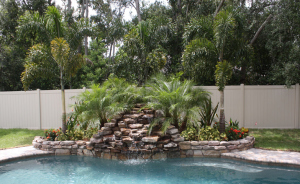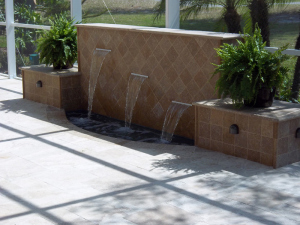The Art of Pavers and Tile
Although beauty is in the eye of the beholder, how many times have you walked through a resort and been blown away by the walkways and tile? Have you marveled at the intricate designs or different shades in order to create a beautiful path? How many times have you taken pictures and saved them for your “Household Ideas File”? Welcome to the intricate world of pavers and tile.
A Beautiful Foundation
According to different sources, interlocking pavers have been around for about 5000 years. Built over a compacted stone sub-base and a leveling bed of sand, they were used in roads, walkways and the like because they could withstand temperature differentials better than other materials. As they are laid, there is space in between so that during extreme cold or heat, they can move without affecting the line of the path that they have paved. As they naturally shift to acclimate to the weather, they don’t crack like cement sidewalks. As an added bonus, the “spaces in between” affect water drainage because when the water hits pavers, it follows the seams to drain away without creating annoying puddles.
Build your Backyard Masterpiece
 Paver and tile design can be a little overwhelming because there are so many choices. Tropical Pools and Pavers can help you pick the right colors and the right design. You can mix and match tiles based upon different focal areas that you want to create. If you want a pool with a rock waterfall feature, you can match the pavers to the stone that you use in the waterfall. But don’t stop there, because you can also create special patterns in the pool tile or pavers that sets off the beauty in the waterfall.
Paver and tile design can be a little overwhelming because there are so many choices. Tropical Pools and Pavers can help you pick the right colors and the right design. You can mix and match tiles based upon different focal areas that you want to create. If you want a pool with a rock waterfall feature, you can match the pavers to the stone that you use in the waterfall. But don’t stop there, because you can also create special patterns in the pool tile or pavers that sets off the beauty in the waterfall.
Focus the Eye
Now, if you look at the picture of the waterfall, you can see how the combination of pavers and tiles allows the wall to be the focus. The pavers are a lighter color and more of a background element. The tile color and design catches your eye but meshes with the natural garden background. Visit our Gallery
Durable Design
Although pavers require very little maintenance, you might want to have them sealed to ensure that they retain their color and beauty. Although pavers are designed as a natural element, their colors can fade over time due to the heat. Tile also does not require a lot of maintenance (although we did write about how to clean calcification in an earlier blog), and based upon your pool design, can be changed over time as your tastes change or if you want to update an existing pool.
At Tropical Pools and Pavers, we install beauty and durability to create your backyard paradise. If you have any questions regarding a new pool design, a walkway or how to update your backyard, please feel free to contact us at 727.474.2142.
Happy Swimming!
Balancing those chemical levels. A little goes a long way
Swimming Pool Start Up, the right way to enjoy new pool, spa.
After your new pool has completed the system start-up phase – which takes about 30 days – most pool companies recommend that you run your pool approximately 6 – 8 hours per day. However, in the summer time, you can split those hours and run your pool approximately 3-4 hours in the morning and the same in the evening. This allows the pool to stay clean while maintaining the chemical level.
Balancing the chemical levels in your swimming pool or spa
To ensure that your pool stays balanced, you should always test the Chlorine, pH, Alkalinity & Hardness levels of your pool. After 30 day start-up period, you can test the water with a home kit or go visit your local pool supply company. They will test your water and give you a printed report with your results and their recommendations of chemicals that you need to add. This can make it a lot easier to maintain a schedule of chemical maintenance. As a heads-up, Saturday mornings are normally the busiest time so if you don’t want to wait in line, you might want to test on a different day.
Check the swimming pool filter and the lines
If you have completed all of the chemical testing, but you are experiencing weird spikes or occasional issues with the water, check your lines and your filter. If the filter is dirty or there is a clog in your line, the chemicals are unable to properly circulate which can cause issues. As a rule of thumb, if you operate an automatic pool cleaner, make sure you clean the filter at least once a week.
Don’t Panic about the Pressure
We recently received a question regarding the water pressure. When your pool starts the daily cycle, it takes a few minutes to come up to full pressure. This is normal and nothing to fret over. When your motor is turned off, there is nothing to make the water circulate and it will take a few minutes for the motor to come up to speed.
Insects and Rats and Snakes. Oh My!
With the recent drought and subsequent rain-fest brought on by Mother Nature, we received a lot of questions regarding how to control pests around your pool. During a drought, pests are simply looking for water and don’t mean to die in your pool. However, once they die, they can cause chemical imbalances and other issues for your pool.
How can you help prevent these intrusions?
If you have seen rodents or other pests in or around your pool area – get a cat. Okay, just kidding. Here are the easy ways to prevent intrusions:
- If you have a screen surrounding the pool area, check all of the screen panels to make sure that the spline (the flat rope material that keeps the screens onto the frame) is intact and hasn’t been pulled out by an adventurous rodent. Look for tiny tears in your screens and fix these immediately. A mouse or snake can squeeze in the smallest of holes. This also applies to the “roof” of your screened enclosure. Have you ever seen a fruit rat or a snake crawling along the top? We have, so make sure you cut off this access. If you have any doors in your screen enclosure, double check that the “rubber sweep” at the bottom of each door is in good condition. Make any repairs as soon as possible.
- Do you have a wood pile, recycling bin or other random building materials in your yard? Rodents will see these as an escape from the heat and build their nests under these areas. Purchase some containers that can be used as storage and get these off of the ground. For example, you can make a simple wood pile holder by using bricks or pavers as a base and assembling the wood in a “crossing” method that allows the wood to be protected without creating a happy home for the local squirrels.
- Do you have trash cans in your backyard? Make sure these have a locking mechanism so rodents won’t be able to access these areas.
- If you don’t have a screened enclosure, look at purchasing a pool cover that perfectly fits your pool. Every night, make sure this is in place as these are their hours of exploration.
If you find a dead rodent in your pool:
- Remove it immediately and dispose of it in a trash can to prevent the spread of germs.
- Shock your pool with chlorine according to the instructions given to you by your local pool supply store. Make sure you run your pool system while you are shocking it to remove all potential-illness germs.
- Thoroughly wash your filter.
- This should remove any bacteria including Giardia and others.
At Tropical Pools and Pavers, we understand that the occasional rodent will fall into your pool. However, quick removal and shock treatment should fix any issues. If you have any questions regarding your pool, please feel free to contact us by calling 727.474.2142.
Happy Swimming!
Make those tiles sparkle!
Over the last few weeks, we had a lot of rain and you probably had to drain some water… However, after you drained the excess water from your pool, you might have noticed a slight bathtub ring. If you have a chance in the next few days, here are a few ways to clean the tiles and prevent further damage to your pool.
Why does the “bathtub ring” matter?
If you don’t clean your tiles on a regular basis, the dirt and oil can calcify on your tiles and permanently damage them. Once the calcification process occurs, you will need to call in a specialist to remove the damage without hurting your pool. In order to prevent this and other harmful agents:
- Sweep all of your tiles at least once a week. Start at the rim of the pool and brush down in even strokes. Don’t forget to vacuum the pool floor in order to pick up any of the excess dirt that you removed from the walls.
- Clean your tiles on a regular basis with a phosphate-based pool tile cleaner that you can buy at your pool supply store. This prevents algae build-up on the tiles and grout. Follow the directions on the cleaning solution, but normally you will apply the cleaner with a sponge and let it sit for about 10 minutes prior to wiping off.
- Did you know algae can also permanently damage your tiles and the grout? In order to mitigate algae penetration, use a telescoping tile cleaning brush. If you see any marks on the tile after you have swept each wall, you can use a tile-cleaning pumice stone and lightly rub on each mark and watch them disappear. This is also true of calcium deposits. If you start to see dingy white or gray buildup, use the pumice stone and work your way around the perimeter. After you have completed these processes, you definitely want to vacuum up the debris from the bottom of the pool.
- Do you have a suntan-lotion scum line? Although you can prevent this build-up by adding enzymes to your pool each week, if you start to see an oily residue on the tiles, use a low-sudsing, non-soap cleaner to remove it.
At Tropical Pools and Pavers, we encourage preventative maintenance and these simple steps will help keep your tile sparkling as well as save you lots of money on tile repair or professional cleaning. If you have any questions regarding your pool, please feel free to contact us.
Happy Swimming!
It’s raining, it’s pouring. Is your pool overflowing?
At Tropical Pools and Pavers, we are happy that the rain is here, but we don’t want your pool to match your grass. So take a few minutes this weekend to head-off any potential issues.
- Clean out the leaves, the frogs or the bugs. (Friendly reminder: please don’t use your metal pool cleaning poles during a lightning storm.) Any decaying material should be removed to prevent an imbalance.
- Test your water and fix all of your chemical levels as soon as possible. This is also true for your Muriatic Acid levels. Muriatic Acid helps prevent staining problems in your pool and these can quickly occur when the chemicals are diluted due to the recent storms.
- Drain the excess water from your pool. To keep your water balanced, drain your pool to the middle of the skim line, but remember – NEVER leave your pump unattended while you complete the process. As a quick reminder:
- If you have a D.E. Filter make sure your pump is off, roll out your layflat hose (blue hose) and turn the black multi-port valve to waste. Turn Pump “ON.” Once you have reduced the water level, turn the valves back to your normal operating settings.
- If you have a Cartridge Filter make sure your pump is off, roll out your layflat hose (blue hose) then open the red handle ball valve that is located next to your filter. Turn Pump “ON.” Once you have reduced the water level, close the valve and return to your normal operating settings.
Once you have fixed all of the levels, don’t forget to have fun. One of our favorite things to do is to swim in our pool during a good rain storm. Of course, make sure it’s not lightning, but take a moment to go under water, open your eyes and look up at all of the raindrops hitting the surface of your pool.
